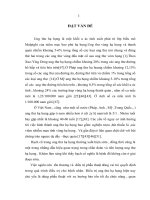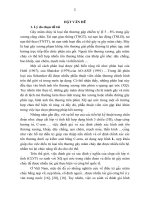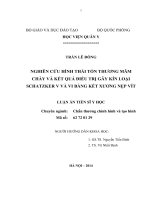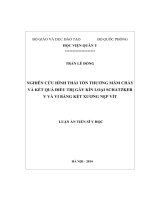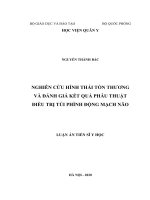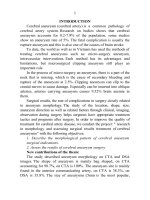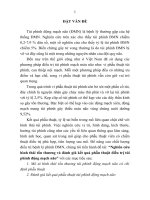Mô tả hình thái tổn thương và các tác nhân gây viêm phần phụ ở bệnh nhân mổ nội soi tại BVPSTW_Tiếng Anh
Bạn đang xem bản rút gọn của tài liệu. Xem và tải ngay bản đầy đủ của tài liệu tại đây (1.03 MB, 23 trang )
<span class='text_page_counter'>(1)</span><div class='page_container' data-page=1>
DESCRIBE THE MORPHOLOGIC LESION AND
PELVIC INFLAMATORY DISEASE FACTORS IN
LAPAROSCOPIC PATIENTS IN NATIONAL
HOSPITAL OF OBSTETRICS AND
GYNECOLOGY 2015 – 20
16
</div>
<span class='text_page_counter'>(2)</span><div class='page_container' data-page=2>
<sub>Pelvic inflamatory disease ( PID ) is a fairly common form </sub>
of infection
<sub>Medical treatment: high dose combination of antibiotics, </sub>
easy to recurrent chronic PID
<sub>Endoscopic surgery for the treatment of PID is valuable in </sub>
the evaluation and management of injury as well as the
finding of an infectious agent that precisely contributes to
the diagnosis, management and prognosis of the best
</div>
<span class='text_page_counter'>(3)</span><div class='page_container' data-page=3>
<sub>PID are usually caused by sexually transmitted infections, </sub>
after abortion, not sterile.
<sub> Common microbiological agents are gonorrhea, </sub>
tuberculosis, staphylococcus, streptococcus. PID is a acute
and chronic PID.
<sub>At the National Hospital Obstetrics and Gynecology from </sub>
2007 to 2010 in 425 cases of PID, 129 cases treated by
</div>
<span class='text_page_counter'>(4)</span><div class='page_container' data-page=4>
<i><b>“Describe the morphologic lesions and PID factors in </b></i>
</div>
<span class='text_page_counter'>(5)</span><div class='page_container' data-page=5>
<sub>General damage of the PID </sub>
<sub>Fallopian tube: </sub>
<sub> Salpingitis and edema. </sub>
<sub> Tubal fimbria stick at levels </sub>
<sub>+ Tightening of the fallopian tube. </sub>
<sub>+ The stick completely create the bar seal </sub>
<sub>+ Stick to the pelvis floor or the cut-de-sac. </sub>
<sub>+ Stick with the organs in the pelvis. </sub>
<sub>+ Hydrosalpinx. </sub>
</div>
<span class='text_page_counter'>(6)</span><div class='page_container' data-page=6>
<sub>Varian and pelvic lesion: </sub>
_ Inflammation stick with the uterus.
_ Inflammation sticking to the organs in the sub-frame
_ Inflammation → Follicles do not release ovules , ovarian
fibrosis.
_ syndrome
</div>
<span class='text_page_counter'>(7)</span><div class='page_container' data-page=7>
<b><sub>Pathophysiology</sub></b> <sub>: </sub>
_ PID occurs when bacteria move from the vagina or cervix
into the uterus, fallopian tubes, ovaries, or pelvis.
_ Less common are neighboring infections such as
appendicitis or diverticulitis.
<sub>Pathogen:</sub><i><sub> Chlamydia trachomatis,</sub></i> <i><sub>Neisseria </sub></i>
<i>gonorrhoeae</i> (60 - 75%)
<sub>Less commonly :</sub> <i><sub>Mycoplasma hominis</sub></i>
<i>Haemophilus influenzae</i>, <i>Streptococcus Pyogenes</i>
</div>
<span class='text_page_counter'>(8)</span><div class='page_container' data-page=8>
<sub>Image diagnosis is very valuable. </sub>
</div>
<span class='text_page_counter'>(9)</span><div class='page_container' data-page=9>
<sub>CT scan </sub>
Early stage
Thickening of the uterosacral
ligaments
Fallopian tube thick
Ovaries are big
Fluid in the endometrial canal
Late Stage:
Tubo-ovarian abcess
</div>
<span class='text_page_counter'>(10)</span><div class='page_container' data-page=10>
<sub>Magnetic Resonance Imaging ( MRI ) </sub>
MRI image in diagnosis
PID is similar to CT scan
MRI can distinguish fallopian
tube blood stasis and
salpingitis. Distinguish
</div>
<span class='text_page_counter'>(11)</span><div class='page_container' data-page=11>
<sub>The role of laparoscopy in PID </sub>
Laparoscopy is the gold standard
Invasive should not be applied regularly
<sub>Indication: </sub>
• Did not respond to antibiotic treatment at the health
establishment from 48 - 72 hours
• Need to drain the fluid
In the abscess by the PID
</div>
<span class='text_page_counter'>(12)</span><div class='page_container' data-page=12>
<sub>Location and time of study: </sub>
Department of Infectious Diseases and Department of
gynecology in National Hospital of Obstetrics and
Gynecology
<sub>Research time: from 01/2015 to 12/2016. </sub>
<sub>Research subjects:Patients diagnosed with PID are </sub>
indicated for surgery after medical treatment but little or
chronic PID.
</div>
<span class='text_page_counter'>(13)</span><div class='page_container' data-page=13>
2.1
21.2
39
16.3
9.9
11.3
0
5
10
15
20
25
30
35
40
45
unletted primary school elementary
school
high school secondary
schools
University
Infections occur mainly in patients aged 20-40 years,
accounting for 56.7%. Age 41-50 has a high rate of PID,
32.6%.
Patients with education elementary school or higher
accounted for nearly 80%.
</div>
<span class='text_page_counter'>(14)</span><div class='page_container' data-page=14>
Laparoscopy
Laparotomy
In 141 patients with PID who had surgery for
laparoscopic surgery, 12 patients (8.5%) underwent
laparotomy because the abdominal cavity was too
adhesive to observe the lesions.
</div>
<span class='text_page_counter'>(15)</span><div class='page_container' data-page=15>
0
20
40
60
80
100
120
140
Adhesive whole Adhesive strip in the live Adhesive uterus-tubo-ovarian Addominal fluid
n
<b>Chart 3: Abdominal Laparotomy </b>
-129 patients with laparoscopy: 44 had lesions in the liver
(34.1%). 100% of patients had adhesive
uterine-tubo-ovarian.
</div>
<span class='text_page_counter'>(16)</span><div class='page_container' data-page=16>
Inflammation block
location
Right
Left
Two side
37
29
75
26,2
20,6
53,2
Property
Full of water
Pus
Abcess
44
66
31
31,2
46,8
22
Size
< 2cm
2 – 5cm
</div>
<span class='text_page_counter'>(17)</span><div class='page_container' data-page=17>
<b>treatment </b> <b><sub>n </sub></b> %
<b>Open Fallopian tube </b> 44 31,2
<b>Salpingolysis </b> 141 100
<b>Drainage </b> 96 68
<b>Cat a Fallopian tube </b> 32 22,7
<b>Salpingectomy </b> 48 34
<b>Salpingo - ovariectomy </b> 13 9,2
<b>Hystero - oophorectomy </b> 4 2,8
</div>
<span class='text_page_counter'>(18)</span><div class='page_container' data-page=18>
<b>Chart 4: Rate of bacteria culture in </b>
<b>abdominal fluid </b>
Negative
Enterobacter
E - Coli
Klebsiella
85.3% of patients with abdominal implant have no
bacteria
</div>
<span class='text_page_counter'>(19)</span><div class='page_container' data-page=19>
<sub>PID occurs mainly in patients aged 20 to 40 years: 56.7%, </sub>
the age of the strongest sexual activity, so susceptible to
sexually transmitted infections. Age 41-50 has a relatively
high rate of PID (32.6%), often hospitalized with severe
infection symptoms.
<sub> There is no link between educational level and PID. </sub>
</div>
<span class='text_page_counter'>(20)</span><div class='page_container' data-page=20>
<b>Abdominal condition: </b>12 patients underwent laparotomy: 3 cases of
peritoneal tuberculosis, 9 patients acquired tubo – ovarian abscess
sticking attached to the uterus, intestine → MRI scan if the boundary
of mass is indistinctive (5/12)
<sub>34,1 % had liver adhesion by Chlamydia </sub>
<sub>53,2% patients had inflammatory mass on either side </sub>
<sub>46,8% were fallopian tuberosity(clinical: severe infection, </sub>
antibiotics was used but this condition is unending). fallopian
tuberosity and tubo – ovarian abscess: Thorough handling by cutting
the fallopian tuberosity cobined or not with ovarian, laving
abdomen, drainage. There are no cases of complications after
surgery.
<sub>Aqueous fallopian tube was easily confused with ovarian tumors, </sub>
</div>
<span class='text_page_counter'>(21)</span><div class='page_container' data-page=21>
<b>Isolation of bacteria </b>:
<sub>Fluid in abdomen of 123 patiens underwent surgery will be </sub>
made bacterial culture
<sub>85.3% of cases was not found bacteria when abdominal </sub>
fluid was cultured, This result is known by all patients
taking high doses of antibiotics before surgery.
<sub>The most popular is Ecoli (5.7%). </sub>
</div>
<span class='text_page_counter'>(22)</span><div class='page_container' data-page=22>
- Laparascopy: 99,3% cases got the size of inflammation mass
> 3cm, 53,2% patients had inflammatory mass on either side,
fallopian tuberosity occupied 46,4%
- 100% of the patients are removed the adhesion, laving
abdomen. 68% cases in cases of fallopian tuberosity, tubo –
ovarian abscess was drainage
- 34,1 % had liver adhesion by Chlamydia.
- The most popular is Ecoli
</div>
<span class='text_page_counter'>(23)</span><div class='page_container' data-page=23></div>
<!--links-->
